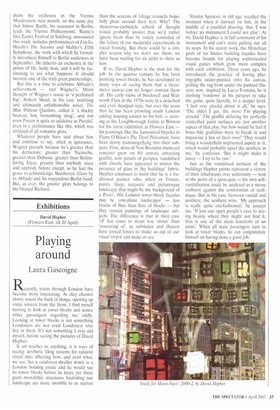David Hepher (Flowers East, till 20 April)
Playing around
Laura Gascoigne
Recently, trains through London have become more interesting. As they chunter slowly round the back of things, opening up vistas unseen from the front, I find myself turning to look at tower blocks and notice other passengers regarding me oddly. Looking at tower blocks is not something Londoners do, not even Londoners who live in them. It's not something I ever did myself, before seeing the pictures of David Hepher.
If art teaches us anything, it is ways of seeing: aesthetic filing systems for random visual data affecting how, and even what, we see. Set a rainforest-dweller down in a London housing estate and he would see its tower blocks before its trees, yet these giant monolithic structures bestriding our landscape are more invisible to us natives than the screens of foliage councils hopefully plant around their feet. Why? The monstrous-carbuncle school of thought would probably answer that we'd rather ignore them than be rudely reminded of the failure of our modernist experiments in social housing. But there could be a simpler reason why we don't see them: we have been waiting for an artist to show us how.
If so, David Hepher is the man for the job. In the quarter century he has been painting tower blocks, he has developed so many ways of seeing them that a threemetre canvas can no longer contain them all. His early views of Stockwell and Walworth Flats in the 1970s were in a detached and even deadpan style, but over the years that he has been prowling south London adding housing estates to his belt — arriving at the Loughborough Estate in Brixton for his latest exhibition at Flowers East — his paintings, like the humanised bicycles in Flann O'Brien's The Third Policeman, have been slowly transmogrifying into their subjects. First, skins of New Brutalist shuttered concrete grew on his canvas, attracting graffiti; now panels of perspex, vandalised with chisels, have appeared to mirror the presence of glass in the buildings' fabric. Hepher continues to insist that he is a traditional painter who, when in France, paints 'deep, recessive and picturesque landscape that might be the background of a Piero'. His London tower-block façades may be 'one-plane landscapes' — less blocks of flats than flats of blocks — but they remain paintings of landscape subjects. The difference is that in their case 'of has come to mean less 'about' than 'consisting of', as substance and illusion have joined forces to shake us out of our visual torpor and make us see. Stanley Spencer, in old age. recalled the moment when it dawned on him, in the middle of a youthful drawing, that 'I was before an instrument I could not play'. At 66, David Hepher is in full command of his instrument and can't resist pulling out all its stops. In his recent work, the Mondrian grids of his Sixties building façades have become boards for playing sophisticated visual games which grow more complex with each exhibition. Three years ago, he introduced the practice of having photographs under-printed onto his canvas, pulling the rug from under the painted illusion: now, inspired by Lucio Fontana, he is slashing 'windows' in his pictures to take the game, quite literally, to a deeper level. 'I feel very playful about it all,' he says. 'The older I get, the more I'm playing around.' The graffiti defacing his perfectly controlled paint surfaces are just another aspect of that play, but how would he feel if bona fide graffitists were to break in and improvise a few of their own? 'They would bring a wonderfully unplanned aspect to it, which would probably upset the aesthete in me,' he confesses. 'But it might make it rawer — I try to be raw.'
Just as the vandalised surfaces of the buildings Hepher paints represent a victory of their inhabitants over uniformity — won at the point of a spray-gun — his own selfvandalisation could be analysed as a messy outburst against the conformism of technique. But in his case, between vandal and aesthete, the aesthete wins. 'My approach is really quite old-fashioned,' he assures me. 'If you can open people's eyes to seeing beauty where they might not find it, that is one of the main functions of an artist.' When all train passengers turn to look at tower blocks, he can congratulate himself on having done a good job.






























































 Previous page
Previous page